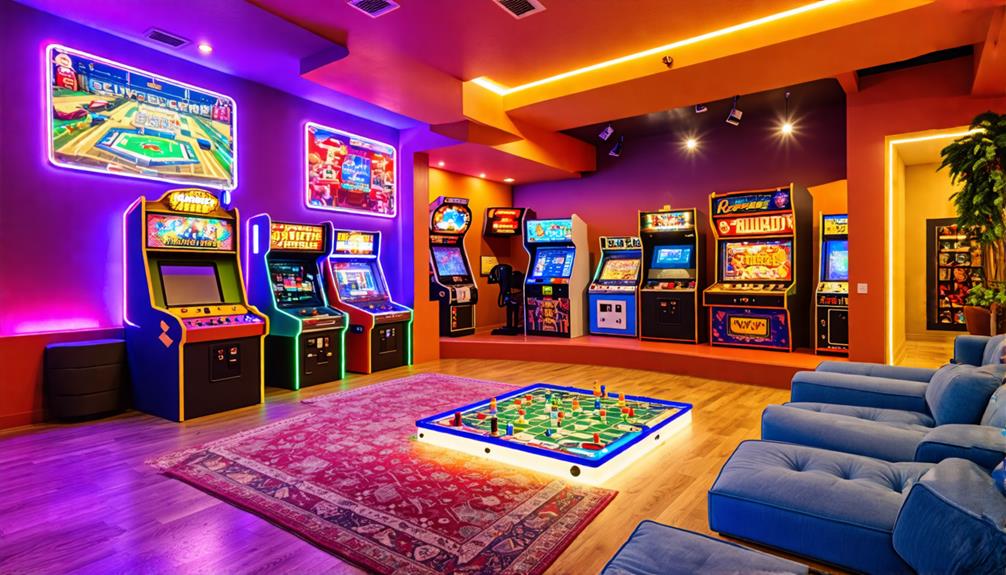Arcade Games vs. Video Consoles: Which Is Best for Your Home Game Room?
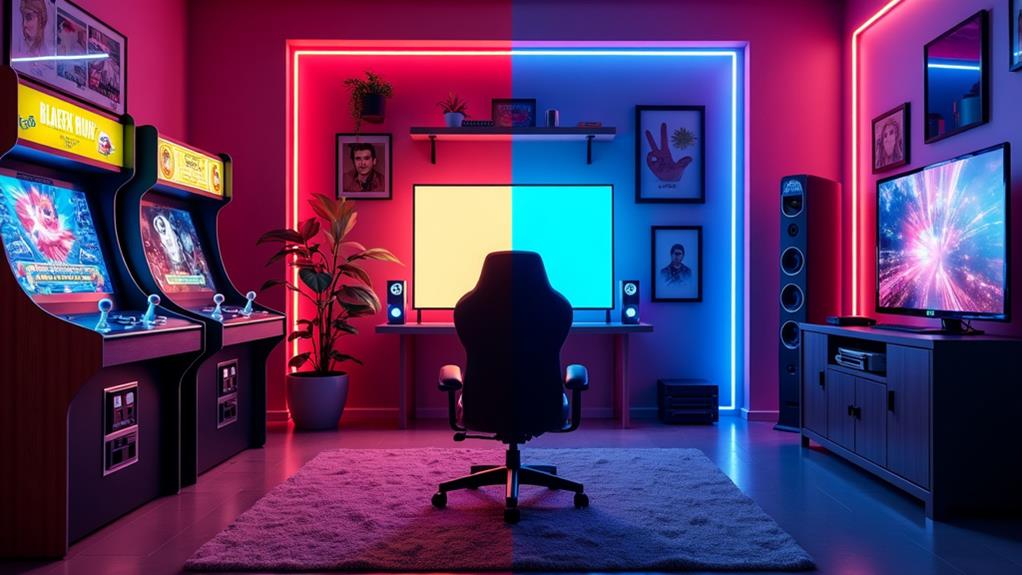
Choosing between arcade games and video consoles for your home game room depends on what you value in your gaming experience. Arcade games deliver intense, skill-based gameplay with nostalgic charm and unique controls, perfect for reliving childhood memories. Video consoles, on the other hand, offer a vast array of genres, long-term engagement, and unmatched convenience, letting you play comfortably from home. If community and social interaction are crucial, arcades may appeal more, but consoles provide flexible, extensive gaming options. Curious about which setup might perfectly suit your needs? You're just a step away from making an informed decision.
Preferences and Nostalgia
Nostalgia plays a powerful role in shaping gaming preferences, with many players longing for the unique atmosphere and social interactions that arcades offered during their childhood. You might remember the thrill of stepping into an arcade, the sound of coins clinking, and the hum of machines creating an engaging experience that home consoles often can't replicate. It's no wonder that these memories influence your gaming platform choice today.
Arcades fostered a sense of community and belonging through competitive multiplayer sessions. These weren't just games; they were social events where you'd meet friends and rivals. The emotional connection you felt to those classic arcade games, which boasted superior graphics and audio for their time, still drives your interest in retro gaming.
Even though home consoles offer convenience and comfort, they sometimes lack the lively environment and dedicated controls of arcade cabinets. Thankfully, emulators and MAME allow you to access vintage arcade titles, letting you relive those nostalgic moments without the need for original hardware. Your preferences might lean toward these experiences because they reconnect you with the past, blending old-school excitement with modern convenience.
Game Types and Quality
When comparing arcade games to home consoles, you'll find stark differences in game types and quality. Arcade games are often designed for short, intense play sessions that emphasize skill and reflexes. This makes them perfect for action and fast-paced genres. On the other hand, console games offer a broader range of genres, including RPGs and strategy games. These allow for longer, engrossing gameplay experiences with in-depth narratives that draw you in for hours.
In the 80s and 90s, arcade games were known for superior graphics and more gameplay elements compared to their home console ports. However, this has changed over time. Modern console games have improved considerably, sometimes even surpassing the original arcade experiences regarding graphics and content.
Arcade games tend to maintain a higher difficulty level, which promotes challenge and skill development. This can make them more rewarding for players seeking a tough experience. Console games, conversely, are often more forgiving, allowing you to investigate and enjoy the game world at your own pace.
Gameplay Mechanics
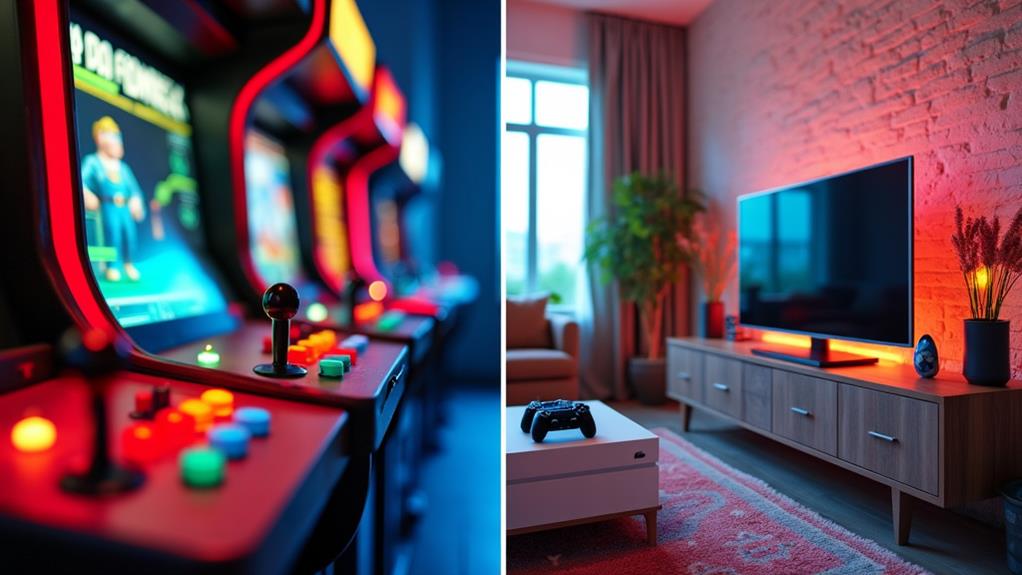
Arcade games stand out for their unique gameplay mechanics, often featuring specialized controls like joysticks, dance pads, and light guns that create a tactile and engaging experience. These mechanics emphasize short, intense play sessions designed for quick reflexes, crafting a high-stakes arcade environment where competition and skill development thrive. You'll find that the challenging nature of arcade games, with their high difficulty levels, keeps you invested and returning for more, sharpening your skills with each playthrough.
In contrast, home console games usually offer longer, more engaging gameplay experiences. These games let you investigate expansive open worlds and immerse yourself in story-driven narratives over extended periods. The gameplay mechanics in console games often focus more on strategy and long-term character development, providing a different kind of satisfaction compared to the high-octane thrills of arcade games.
If you're looking to recreate the intense, competitive atmosphere of an arcade environment in your home game room, arcade games are a fantastic choice. Their gameplay mechanics prioritize skill and reflex, delivering a challenging and rewarding experience that stands in stark contrast to the more forgiving and exploratory nature of many home console games.
Control Schemes
How do control schemes impact your gaming experience? When you plunge into an arcade game, you're greeted with unique control schemes designed specifically for that game's mechanics. Think of the classic joystick and specialized buttons on games like Tempest and Tron. These controls aren't just there for show; they improve player interaction and make the experience more engaging.
On the other hand, console gaming often relies on generic controllers. While modern consoles have advanced considerably, their controllers can't always match the tailored design of arcade controls. This can make some games feel less captivating when you play them at home compared to their arcade counterparts. The tactile feedback from arcade controls offers a level of intensity and engagement that's hard to replicate with standard console inputs.
Arcade games are engineered to optimize engagement through their dedicated controls, creating a physical interaction that's particularly gripping in fast-paced action games. While home consoles have made strides in control technology, they still lag behind the specialized controls found in arcade cabinets. If you're looking for an unparalleled gaming experience, the unique control schemes of arcade games might just be what you need for your home game room.
Community Engagement
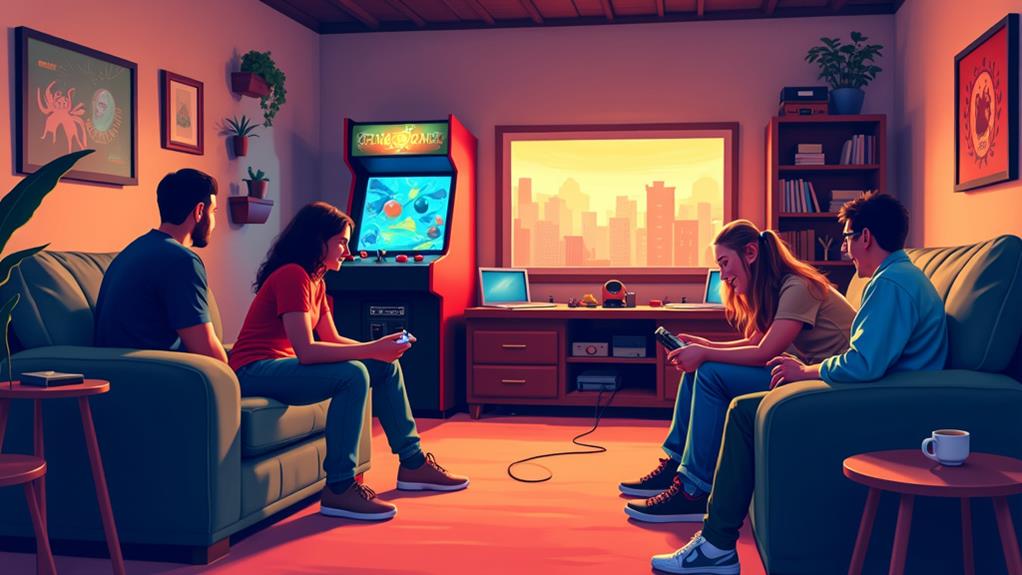
Community engagement in gaming thrives on the camaraderie and shared experiences that arcades distinctly provide. When you step into an arcade, you're not just playing games; you're interacting with fellow gamers, sharing tips, and sometimes even competing in local tournaments. Arcades mostly foster a sense of belonging, making you feel part of a larger community. These events and tournaments are fantastic ways to improve community engagement, allowing you to meet new people and bond over your favorite games.
Arcades mostly excel in creating an environment where social interaction is natural and encouraged. The nostalgia of traditional arcade settings drives many gamers to seek out these communal experiences, highlighting the importance of physical spaces in fostering connections. While home gaming can sometimes lead to solitary play, arcades provide a lively, social atmosphere that's hard to replicate.
Interestingly, collecting arcade machines has become a popular social activity. Enthusiasts often share their collections and experiences on online forums and community platforms. This bridges the gap between home and arcade gaming, allowing you to connect with like-minded individuals and keep the communal spirit alive, even outside the physical arcade.
Convenience of Consoles
While arcades excel at fostering social interactions, home consoles bring unparalleled convenience to the gaming experience. You can enjoy gaming from the comfort of your own space without needing to travel to an arcade. This eliminates the hassle of commuting and lets you immerse yourself in your favorite games whenever you please.
Home consoles offer extensive libraries of games across different genres, giving you a diverse gaming experience that physical arcade machines simply can't match. Regardless of whether you're into action-packed shooters, intricate RPGs, or casual puzzle games, home versions have you covered. Plus, you can enjoy flexible gaming times, allowing for sessions of any duration without worrying about the financial investment per play.
Digital downloads and automatic updates mean you can access the latest games and patches without ever stepping into a store. This feature guarantees you're always up-to-date with new content and improvements. Consoles also facilitate solo or online multiplayer interactions, providing a mix of personal gaming experiences and community engagement from home. Regardless of if you prefer playing alone or competing with friends, consoles offer the best of both worlds, all within the comfort of your own home.
Arcade Business Dynamics
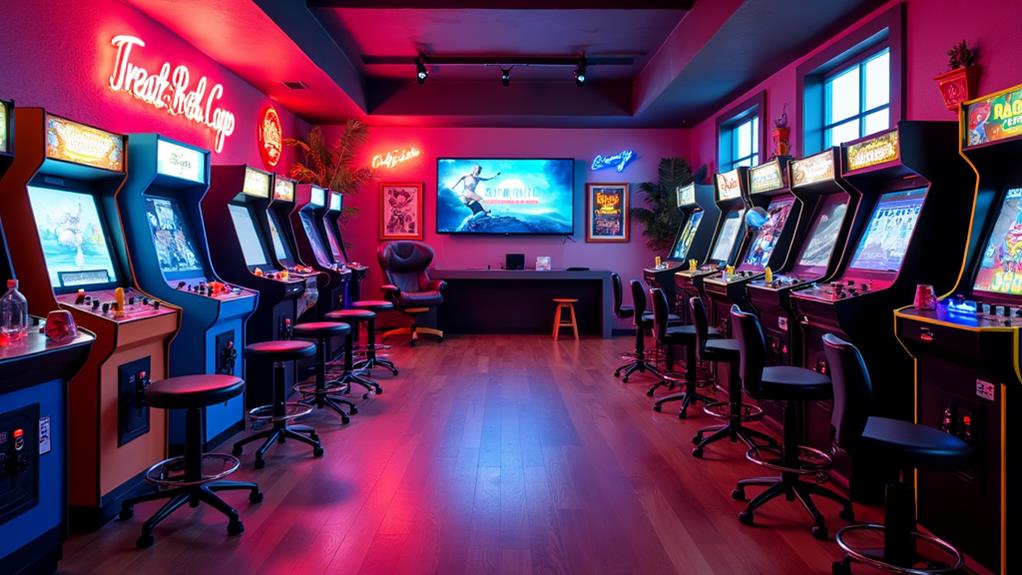
The economics of running an arcade are intricate and multifaceted, shaped by revenue-sharing agreements between machine operators and business owners. These agreements directly impact profitability, dictating how earnings from each game play are divided. Traditionally, arcade machines operated on a quarter-per-play model, but rising operational costs have pushed charges up to $2.50 per play.
With increased competition from home consoles, many arcades have had to evolve or close. Some have shifted to tourist-centric models like Dave & Buster's, aiming to draw in larger crowds with a mix of entertainment options. This shift highlights the notable decline the arcade industry has faced, compounded by layoffs and bankruptcies.
Investing in arcade cabinets isn't cheap. Standard machines typically cost around $2,000, while specialized machines can average about $5,000. For an arcade to stay profitable, balancing these investments with the revenue generated from players is essential. Game developers also play a vital role in this ecosystem, creating engaging games that can attract and retain customers.
Ultimately, the traditional arcade landscape has been markedly altered by the rise of home gaming systems, forcing the industry to adapt and find new ways to remain relevant and profitable.
Game Design Trends
Game design trends have greatly evolved since the early days of arcade gaming, reflecting broader shifts in technology and player expectations. In the 80s, game makers focused on playability and creativity, delivering iconic arcade versions like Pac-Man and Frogger. These games were designed by small teams who prioritized enjoyable gameplay, ensuring players had fun while challenging their skills.
By the 90s, however, the emphasis shifted. Arcade game design began to prioritize revenue maximization. Operators increased play prices and tweaked difficulty settings to keep you playing—and spending. This shift reflected a broader industry trend that treated arcade machines like vending machines, where profit was king.
Today's game development is far more sophisticated. Game makers use psychological metrics to improve player engagement, often strategically withholding rewards to keep you hooked. Modern games emphasize multiplayer experiences and social interaction, extensively testing player responses to optimize engagement.
Despite the decline of traditional arcades, their influence persists. Nostalgia-driven design leads to new arcade-style games and adaptations that blend the charm of classic arcade versions with cutting-edge technology. For your home game room, understanding these trends can help you choose games that offer the perfect balance of fun and modern engagement.
Modern Gaming Trends
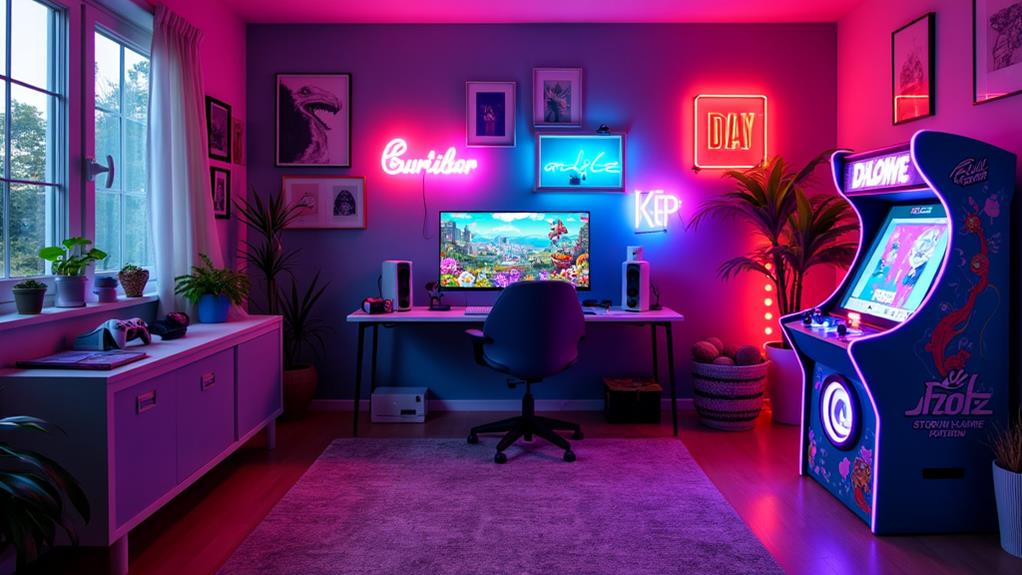
In recent years, modern gaming trends have rapidly evolved, focusing heavily on online play and social interaction. Services like Microsoft Xbox Live, which charges $50/year for multiplayer access, highlight this shift. These modern gaming trends emphasize downloadable content (DLC), leaderboards, and in-game chat functionalities, making gaming more engaging and competitive than ever.
When comparing arcade vs. console experiences, you'll notice that modern consoles have prioritized addictive gameplay mechanics. Developers often design games to withhold rewards, encouraging you to play longer and interact more socially. This stands in stark contrast to the 80s arcade games, which focused more on straightforward, player-centric fun.
These days, game development involves extensive testing and player response analysis. Modern gaming trends utilize psychological design to improve engagement, using metrics to analyze your behavior and preferences. This results in tailored gaming experiences that keep you invested and coming back for more.
As you consider if to outfit your home game room with modern video consoles or classic arcade machines, understanding these trends can help you make an informed choice. While arcades offer nostalgia and simplicity, modern consoles provide rich, social, and highly engaging gaming experiences.
Retro Gaming Culture
Anyone who grew up in the golden age of arcades can't help but feel a wave of nostalgia when they hear the sounds of classic games like Pac-Man or Donkey Kong. Retro gaming culture thrives on this nostalgia, with many enthusiasts enthusiastic to recreate the authentic atmosphere of arcades in their home game rooms. Emulators like MAME have made it easier than ever to access a vast library of classic arcade games without needing original hardware, enhancing the popularity of retro gaming.
Collecting arcade machines and classic consoles has become a cherished hobby for many. Prices for vintage arcade machines often range from $300 to $600, while pinball machines can fetch up to $3,000. This pursuit of authentic equipment underscores the desire to preserve the tactile and visual experiences of retro gaming.
Community engagement is another cornerstone of retro gaming culture. Podcasts and online forums dedicated to arcade games foster connections among enthusiasts, supporting the preservation of arcade culture and shared experiences. Events like bar-cades and mobile arcade setups bring retro gaming to new generations, allowing them to experience the social aspect of arcades. This shared love for retro gaming keeps the legacy of classic arcade games alive and well.

